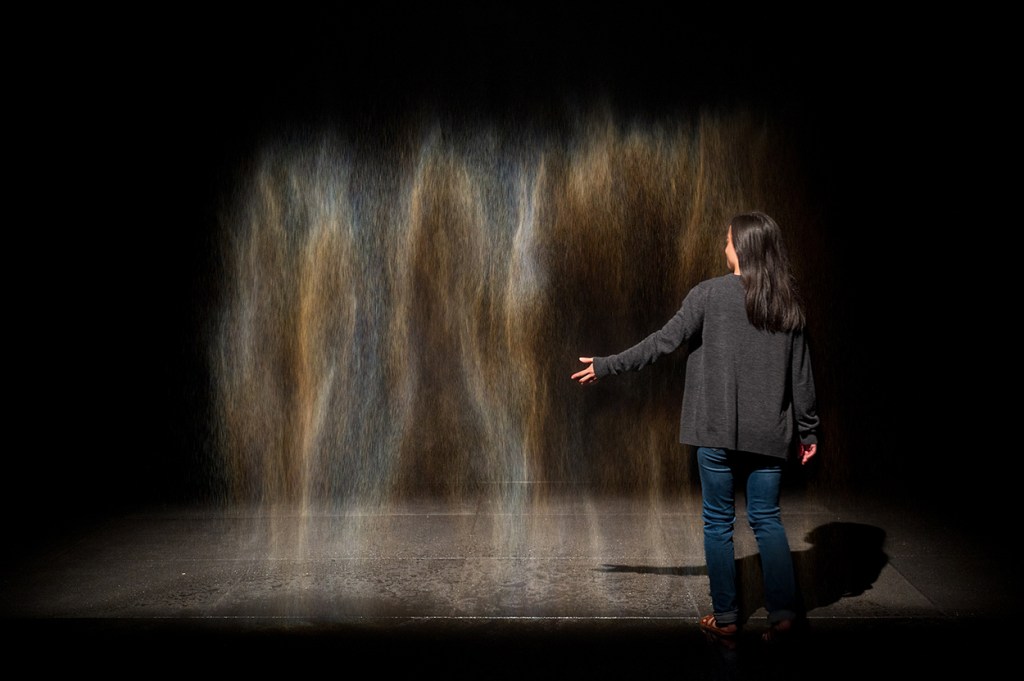Olafur Eliasson Gets Lost in the Disconnect Between Science and Spectacle (kaamsechitrakaar)
[ad_1]
Olafur Eliasson’s survey “Your Curious Journey” announces the artist’s environmentalist priorities in the opening work: a series of before-and-after photographs of Icelandic glaciers titled “The Glacier Melt Series 1999/2019.” Images taken in 1999 and 2019 are displayed side-by-side in the exhibition, organized by the Singapore Art Museum and traveling around Southeast Asia and New Zealand through 2026. The paired images, arranged in a grid, reveal substantial loss of glacial ice over time.
Olafur Eliasson: The Glacier Melt Series 1999/2019, 2019.
Photo Joseph Nair. Image courtesy the artist and Singapore Art Museum. © 2019 Olafur Eliasson.
Eliasson has committed his practice to raising climate awareness since the 1990s. The most famous example is his 2014 project Ice Watch, which saw chunks of icebergs harvested from a fjord, then spectacularly installed in European capitals, where locals watched them melt. Here, as in The Glacier Melt Series, viewers were made to witness effects of climate change that can feel distant or hard to see.
But where Ice Watch generated the kind of participatory engagement for which Eliasson is known, with visitors touching the ice and moving around and through it, The Glacier Melt Series reads like a geography textbook. The succession of 30 comparisons is relentlessly didactic, leaving little room for affect or interpretation. And perhaps this is part of Eliasson’s point: there should be no bones about climate change.
Still, it’s hard to reconcile this work with the erratic delight of Ventilator (1997) hanging nearby. An electric fan moves of its own accord, making swooping arcs through the gallery. Ventilator speaks to the constantly shifting dynamics of intentions and consequences: Its motorized function was initiated by human action, but its subsequent movement is propelled by forces beyond the artist’s control. Tracking the fan’s unpredictable trajectory generates an experience that is closer to what it is to live with climate change, rather than to look at it as a before and after, a fait accompli.

View of “Olafur Eliasson: Your Curious Journey,” 2024, at the Singapore Art Museum.
Photo Joseph Nair. Image courtesy the artist and Singapore Art Museum.
Such static qualities also characterize one of the show’s newest pieces, The Last Seven Days of Glacial Ice (2024). In this sculpture, the ice has no chance of melting, as it has been rendered in bronze. Based on the dissolution of an ice block Eliasson recovered from the south of Iceland (he was raised in Denmark by Icelandic parents), each of seven successively smaller bronze casts is paired with a glass orb representing the volume of water lost. The bronze aligns the piece with classical sculpture, making the work a monument, the iceberg, something of the past to contemplate from a distance. The die has been cast; little remains for the viewer to do.
The Last Seven Days turns water into glass, something fixed and hard. Beauty (1993), by contrast, expands water’s perceptual resonance in ways that invite engagement and marvel. Gently falling mist combines with projected light and the viewer’s perception to create an ethereal rainbow.

Olafur Eliasson: The Last Seven Days of Glacial Ice, 2024.
Photo Joseph Nair. Image courtesy the artist and Singapore Art Museum. ©2024 Olafur Eliasson.
Lasers and fog comprise Symbiotic Seeing (2020), on an upper floor in the Singapore Art Museum stop, and together generate an ever-changing cloudscape, supposedly attuned to the moving heat of the viewer’s body. I tried and failed to find the interactive component of the swirling mist; there, in the darkened space of the installation, the glaciers are far from view. The same can be said for Eliasson’s new work at the Museum of Contemporary Art Los Angeles, where a major exhibition devoted to the artist (as part of PST ART: Art & Science Collide) focuses entirely on the optical distortions of kaleidoscopic sculpture. Delight as they may, what I crave is an art that will connect the pleasures of this world with its perils, without diminishing either.
In his best work, Eliasson finds this sweet spot. It appears in a glimpse into the artist’s studio, as part of Movement Microscope (2011). The 16-minute video introduces elements of dance into the labors of everyday life, a subtle interruption of routine that heightens attention to happenstance. We see the work of design and fabrication, but also the wonder of a shared meal, produced by Eliasson’s renowned studio kitchen and sourced in part from an on-site garden. That moment of connection between the small and the grand, the sensory and the social, the local meal and the global conditions impacting its ingredients, felt like the bridge I was missing between so many of the other pieces.

View of “Olafur Eliasson: Your Curious Journey,” 2024, at the Singapore Art Museum.
Photo Joseph Nair. Image courtesy the artist and Singapore Art Museum.
Some of the paradoxes that inhabit Eliasson’s recent work find clear form in Adrift Compass (2019), its title an apparent oxymoron. Compasses should orient us, giving us purpose and direction. This one, made of driftwood, points north, but in the darkness of the gallery, cut off from the outside world, it does indeed leave us adrift. Knowing where to go is not the same as generating movement, just as recognizing the effects of climate change is not the same as stopping it. Eliasson’s recent and more spectacular work may be the product of this frustration, of seeing so clearly the change that has come and yet feeling so acutely our inability to respond.
[ad_2]


